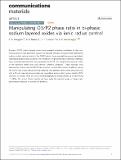Files in this item
Manipulating O3/P2 phase ratio in bi-phasic sodium layered oxides via ionic radius control
Item metadata
| dc.contributor.author | Maughan, P. A. | |
| dc.contributor.author | Naden, A. B. | |
| dc.contributor.author | Irvine, J. T. S. | |
| dc.contributor.author | Armstrong, A. R. | |
| dc.date.accessioned | 2023-02-07T09:30:06Z | |
| dc.date.available | 2023-02-07T09:30:06Z | |
| dc.date.issued | 2023-02-02 | |
| dc.identifier | 283276002 | |
| dc.identifier | b0bbef9e-0c6a-403d-85f0-9aad306e8024 | |
| dc.identifier | 85147329619 | |
| dc.identifier | 000922628700001 | |
| dc.identifier.citation | Maughan , P A , Naden , A B , Irvine , J T S & Armstrong , A R 2023 , ' Manipulating O3/P2 phase ratio in bi-phasic sodium layered oxides via ionic radius control ' , Communications Materials , vol. 4 , no. 1 , 6 . https://doi.org/10.1038/s43246-023-00337-8 | en |
| dc.identifier.issn | 2662-4443 | |
| dc.identifier.other | RIS: urn:3892DA6929683611AA23BC238A477354 | |
| dc.identifier.other | RIS: Maughan2023 | |
| dc.identifier.other | ORCID: /0000-0002-8394-3359/work/128567857 | |
| dc.identifier.other | ORCID: /0000-0003-2876-6991/work/128568176 | |
| dc.identifier.other | ORCID: /0000-0003-1937-0936/work/128568314 | |
| dc.identifier.uri | https://hdl.handle.net/10023/26912 | |
| dc.description | Funding: This work was supported by the Faraday Institution (Grant number FIRG018). The authors would like to thank Dr. David Rochester at Lancaster University for conducting the ICP-OES experiments. A.B.N. would like to acknowledge funding by the Engineering and Physical Sciences Research Council under grant numbers EP/L017008/1, EP/R023751/1, and EP/T019298/1 for the electron microscopy analysis. | en |
| dc.description.abstract | Bi-phasic O3/P2 sodium layered oxides have emerged as leading candidates for the commercialisation of next-generation sodium-ion batteries. However, beyond simply altering the sodium content, rational control of the O3/P2 ratio in these materials has proven particularly challenging despite being crucial for the realization of high-performance electrode materials. Here, using abundant elements, we manipulate the O3/P2 ratio using the average ionic radius of the transition metal layer and different synthesis conditions. These methods allow deterministic control over the O3/P2 ratio, even for constant Na contents. In addition, tuning the O3/P2 ratio yields high-performing materials with different performance characteristics, with a P2-rich material achieving high rate capabilities and excellent cycling stability (92% retention, 50 cycles), while an O3-rich material displayed an energy density up to 430 Wh kg−1, (85%, 50 cycles). These insights will help guide the rational design of future high-performance materials for sodium-ion batteries. | |
| dc.format.extent | 7 | |
| dc.format.extent | 1182558 | |
| dc.language.iso | eng | |
| dc.relation.ispartof | Communications Materials | en |
| dc.subject | QD Chemistry | en |
| dc.subject | NDAS | en |
| dc.subject | MCC | en |
| dc.subject.lcc | QD | en |
| dc.title | Manipulating O3/P2 phase ratio in bi-phasic sodium layered oxides via ionic radius control | en |
| dc.type | Journal article | en |
| dc.contributor.sponsor | EPSRC | en |
| dc.contributor.sponsor | EPSRC | en |
| dc.contributor.sponsor | EPSRC | en |
| dc.contributor.sponsor | The Faraday Institution | en |
| dc.contributor.institution | University of St Andrews. School of Chemistry | en |
| dc.contributor.institution | University of St Andrews. Institute of Behavioural and Neural Sciences | en |
| dc.contributor.institution | University of St Andrews. Centre for Energy Ethics | en |
| dc.contributor.institution | University of St Andrews. Centre for Designer Quantum Materials | en |
| dc.contributor.institution | University of St Andrews. EaSTCHEM | en |
| dc.identifier.doi | https://doi.org/10.1038/s43246-023-00337-8 | |
| dc.description.status | Peer reviewed | en |
| dc.identifier.grantnumber | ep/l017008/1 | en |
| dc.identifier.grantnumber | ep/l017008/1 | en |
| dc.identifier.grantnumber | EP/T019298/1 | en |
| dc.identifier.grantnumber | EP/T005602/1 | en |
This item appears in the following Collection(s)
Items in the St Andrews Research Repository are protected by copyright, with all rights reserved, unless otherwise indicated.

